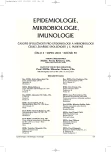Prevalence of Anti-Epstein-Barr Virus Antibodies in Children and Adolescents with Secondary Immunodeficiency
Authors:
A. Bučková
Authors‘ workplace:
Analyticko-diagnostické laboratórium, s. r. o. Prešov, Slovenská republika
Published in:
Epidemiol. Mikrobiol. Imunol. 59, 2010, č. 3, s. 133-137
Overview
Secondary immunodeficiency can be caused by multiple factors. We studied whether there is a relationship between secondary immunodeficiency and Epstein-Barr virus (EBV) infection in children and adolescents. The study group included 845 patients with common variable immunodeficiency aged from 2 to 18 years and 394 age-matched healthy controls. IgM and IgG antibodies against viral capsid antigen (VCA) and IgG antibodies against Epstein-Barr virus nuclear antigen 1 (EBNA-1) were quantitated by an enzyme-linked immunosorbent assay. A statistically significant difference (p = 0.004) in the prevalence of EBV infection was found between the immunodeficient children and controls, both aged 2 to 6 years. The statistically significant difference was confirmed in boys (p = 0.003), but not in girls of this age group.
Key words:
secondary immunodeficiency – Epstein-Barr virus – children – adolescents.
Sources
1. Ambrožová, H. Infekčni mononukleoza. Pediatrie pro praxi, 2005, 6, 5, p. 244–246.
2. Ammatuna, P., Di Stefano, R., Arista, S. et. al. Immune status towards Epstein-Barr virus in a group of sicilian children. European Journal of Epidemiology, 1989, 2, p. 219–223.
3. Auwaerter, P. G. Infectious mononucleosis in middle age. JAMA, 1999, 281, 5, p. 454–459.
4. Bartuňková, J. Imunodeficience. 1.vyd. Praha : Grada, 2002. 184 p. ISBN 80-247-0244-4.
5. Bennet, N. J. Mononucleosis and Epstein-Barr Virus Infection, 2008. Dostupné na
6. Buc, M. Klinicka imunologia. 1.vyd. Bratislava : Veda, 1997. 167 p. ISBN 80-220-0487-X.
7. Crowcroft, N. S., Vyse, A., Brown, D. W., Strachan, D. P. Epidemiology of Epstein-Barr virus infection in preadolescent children: application of a new salivary method in Edinburgh, Scotland. Journal of Epidemiology and Community Health, 1998, 52, p. 101–104.
8. Figueira-Silva, C., Pereira, F. E. L. Prevalence of Epstein-Barr virus antibodies in healthy children and adolescents in Vitoria, State of Espirito Santo, Brazil. Rev. Soc. Bras. Med. Trop., 2004, 37, p. 5.
9. Hammarstrom, P., Hammarstrom, Q. Antibody deficiency diseases. Eur. J. Immunol., 2008, 38, 2, p. 327–333.
10. Kaye, K. M., Kieff, E. Epstein-Barr virus infection and infectious mononucleosis. In: Gorbach, S. L., Bartlett, J. G., Blacklow, N. R., eds. Infectious diseases. Philadelphia: Saunders, 1992.
11. Leogrande, G., Jirillo, E. Studies on the epidemiology of child infections in the Bari area (South Italy). European Journal of Epidemiology, 1993, 9, 4, p. 368–372.
12. Nyulassy, Š. Klinicka imunologia a alergologia pre prax. 2.vyd. Bratislava: Herba, 2002. 71 p. ISBN 80-967994-6-0.
13. Mandell, G. L. et al. Infectious diseases and their etiologic agens. Vydanie tretie, Churchill Livingstone : New York, 1995, p. 1364.
14. Takeuchi, K., Tanaka-Taya, K., Kazuyama et. al. Prevalence of Epstein–Barr virus in Japan: Trends and future prediction. Pathology International, 2006, 56, 3, p. 112–116.
Labels
Hygiene and epidemiology Medical virology Clinical microbiologyArticle was published in
Epidemiology, Microbiology, Immunology

2010 Issue 3
Most read in this issue
-
Lipophilic Yeasts of the Genus Malassezia and Skin Diseases.
I. Seborrhoeic Dermatitis - Pernicious Anaemia – Diagnostic Benefit of the Detection of Autoantibodies against Intrinsic Factor and Gastric Parietal Cells Antigen H+/K+ ATPase
- Herpes zoster in the Czech Republic – Epidemiology and Clinical Manifestations
- Prevalence of Anti-Epstein-Barr Virus Antibodies in Children and Adolescents with Secondary Immunodeficiency
